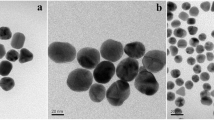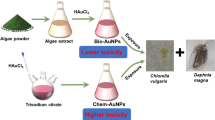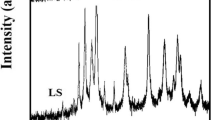Abstract
Gold nanoparticles (GNPs) are widely used for medical purposes, both in diagnostics as well as drug delivery, and hence are prone to release and distribution in the environment. Thus, we have explored the effects of GNPs with two distinct surface capping (citrate and PVP), and three different sizes (16, 27, and 37 nm) at 0.01-, 0.1-, and 1-mg L−1 concentrations on a predominant freshwater alga Scenedesmus obliquus in the sterile freshwater matrix. We have also investigated how an abundant metal ion from freshwater, i.e., Zn2+ ions may modulate the effects of the selected GNPs (40 nm, citrate, and PVP capped). Preliminary toxicity results revealed that gold nanoparticles were highly toxic in comparison to zinc ions alone. A significant modulation in the toxicity of Zn ions was not noticed in the presence of GNPs. In contrast, zinc ions minimized the toxicity produced by GNPs (both CIT-37 and PVP-37), despite its individual toxicity. Approximately, about 42, 33, and 25% toxicity reduction was noted at 0.05-, 0.5-, and 5-mg L−1 Zn ions, respectively, for CIT-37 GNPs, while 31% (0.05 mg L−1), 24% (0.5 mg L−1), and 9% (5 mg L−1) of toxicity reduction were noted for PVP-37 GNPs. Maximum toxicity reduction was seen at 0.05 mg L−1 of Zn ions. Abbott modeling substantiated antagonistic effects offered by Zn2+ ions on GNPs. Stability and sedimentation data revealed that the addition of zinc ions gradually induced the aggregation of NPs and in turn significantly reduced the toxicity of GNPs. Thus, the naturally existing ions like Zn2+ have an ability to modulate the toxicity of GNPs in a real-world environment scenario.





Similar content being viewed by others
References
Abbott MB, Bathurst JC, Cunge JA, O'Connell PE, Rasmussen J (1986) An introduction to the European hydrological system—Systeme Hydrologique Europeen, “SHE”, 1: history and philosophy of a physically-based, distributed modelling system. J Hydrol 87(1):45–59
Albanese A, Chan WC (2011) Effect of gold nanoparticle aggregation on cell uptake and toxicity. ACS Nano 5(7):5478–5489
Ali M, Hashim U, Mustafa S, Man Y, Islam KN (2012) Gold nanoparticle sensor for the visual detection of pork adulteration in meatball formulation. J Nanomater 2012:1
Alkilany AM, Murphy CJ (2010) Toxicity and cellular uptake of gold nanoparticles: what we have learned so far? J Nanopart Res 12(7):2313–2333
Aravind P, Prasad MNV (2005) Modulation of cadmium-induced oxidative stress in Ceratophyllum demersum by zinc involves ascorbate–glutathione cycle and glutathione metabolism. Plant Physiol Biochem 43(2):107–116
Auffan M, Bottero JY, Chaneac C, Rose J (2010) Inorganic manufactured nanoparticles: how their physicochemical properties influence their biological effects in aqueous environments. Nanomedicine 5(6):999–1007
Auffan M, Rose J, Bottero JY, Lowry GV, Jolivet JP, Wiesner MR (2009) Towards a definition of inorganic nanoparticles from an environmental, health and safety perspective. Nat Nanotechnol 4(10):634–641
Badawy AME, Luxton TP, Silva RG, Scheckel KG, Suidan MT, Tolaymat TM (2010) Impact of environmental conditions (pH, ionic strength, and electrolyte type) on the surface charge and aggregation of silver nanoparticles suspensions. Environ Sci Technol 44(4):1260–1266
Behra R, Wagner B, Sgier L, Kistler D (2015) Colloidal stability and toxicity of gold nanoparticles and gold chloride on Chlamydomonas reinhardtii. Aqaut Geochem 21(2):331–342
Bodar CW, Pronk ME, Sijm DT (2005) The European Union risk assessment on zinc and zinc compounds: the process and the facts. Integr Environ Assess Manag 1:301–319
Bray TM, Bettger WJ (1990) The physiological role of zinc as an antioxidant. Free Radic Biol Med 8(3):281–291
Bozich JS, Lohse SE, Torelli MD, Murphy CJ, Hamers RJ, Klaper RD (2014) Surface chemistry, charge and ligand type impact the toxicity of gold nanoparticles to Daphnia magna. Environmental Science: Nano 1(3):260–270
Brown SD, Nativo P, Smith J-A, Stirling D, Edwards PR, Venugopal B, Flint DJ, Plumb JA, Graham D, Wheate NJ (2010) Gold nanoparticles for the improved anticancer drug delivery of the active component of oxaliplatin. J Am Chem Soc 132(13):4678–4684
Campbel PGC, Stokes PM (1985) Acidification and toxicity of metals to aquatic biota. Can J Fish Aquat Sci 42(12):2034–2049
Chesworth J, Donkin M, Brown M (2004) The interactive effects of the antifouling herbicides irgarol 1051 and diuron on the seagrass Zostera marina (L.). Aquat Toxicol 66(3):293–305
Coradeghini R, Gioria S, García CP, Nativo P, Franchini F, Gilliland D, Ponti J, Rossi F (2013) Size-dependent toxicity and cell interaction mechanisms of gold nanoparticles on mouse fibroblasts. Toxicol Lett 217(3):205–216
Cumberland SA, Lead JR (2009) Particle size distribution of silver nanoparticles at environmentally relevant conditions. J Chromatogr A 1216:7
Dalai S, Pakrashi S, Kumar RS, Chandrasekaran N, Mukherjee A (2012) A comparative cytotoxicity study of TiO2 nanoparticles under light and dark conditions at low exposure concentrations. Toxicol Res 1(2):116–130
Dalai S, Pakrashi S, Bhuvaneshwari M, Iswarya V, Chandrasekaran N, Mukherjee A (2014) Toxic effect of Cr(VI) in presence of n-TiO2 and n-Al2O3 particles towards freshwater microalgae. Aquat Toxicol 146:28–37
Dedkova K, Bures Z, Palarcík J, Vlcek M, Kukutschova J (2014) Acute toxicity of gold nanoparticles to freshwater green algae. In: In: conference NanoCon, Nov 5the7th. Czech Republic, Brno
Franklin NM, Stauber JL, Lim RP, Petocz P (2002) Toxicity of metal mixtures to a tropical freshwater alga (Chlorella sp.): the effect of interactions between copper, cadmium, and zinc on metal cell binding and uptake. Environ Toxicol Chem 21(11):2412–2422
Frens G (1973) Controlled nucleation for the regulation of the particle size in monodisperse gold suspensions. Nature 241(105):20–22
Gilroy KD, Neretina S, Sanders RW (2014) Behavior of gold nanoparticles in an experimental algal–zooplankton food chain. J Nanopart Res 16(5):1–8
Gliga AR, Skoglund S, Wallinder IO, Fadeel B, Karlsson HL (2014) Size-dependent cytotoxicity of silver nanoparticles in human lung cells: the role of cellular uptake, agglomeration and Ag release. Part Fibre Toxicol 11(1):1
Goodman CM, McCusker CD, Yilmaz T, Rotello VM (2004) Toxicity of gold nanoparticles functionalized with cationic and anionic side chains. Bioconjug Chem 15(4):897–900
Gottschalk F, Sonderer T, Scholz RW, Nowack B (2009) Modeled environmental concentrations of engineered nanomaterials (TiO2, ZnO, Ag, CNT, fullerenes) for different regions. Environ Sci Technol 43(24):9216–9222
Guo Y, Zhang Y, Shao H, Wang Z, Wang X, Jiang X (2014) Label-free colorimetric detection of cadmium ions in rice samples using gold nanoparticles. Anal Chem 86(17):8530–8534
Hafeez B, Khanif YM, Saleem M (2013) Role of zinc in plant nutrition—a review. American Journal of Experimental Agriculture 3(2):374
Harris PO, Ramelow GJ (1990) Binding of metal ions by particulate biomass derived from Chlorella vulgaris and Scenedesmus quadricauda. Environ Sci Technol 24(2):220–228
Hitchman A, Smith GHS, Ju-Nam Y, Sterling M, Lead JR (2013) The effect of environmentally relevant conditions on PVP stabilised gold nanoparticles. Chemosphere 90(2):410–416
Hu J, Wang D, Forthaus BE, Wang J (2012) Quantifying the effect of nanoparticles on as (V) ecotoxicity exemplified by nano-Fe2O3 (magnetic) and nano-Al2O3. Environ Toxicol Chem 31(12):2870–2876
Iswarya V, Manivannan J, De A, Paul S, Roy R, Johnson J, Kundu R, Chandrasekaran N, Mukherjee A, Mukherjee A (2015) Surface capping and size-dependent toxicity of gold nanoparticles on different trophic levels. Environ Sci Pollut Res:1–15
Iswarya V, Bhuvaneshwari M, Chandrasekaran N, Mukherjee A (2016) Individual and binary toxicity of anatase and rutile nanoparticles towards Ceriodaphnia dubia. Aquat Toxicol 178:209–221
Kahru A, Dubourguier HC, Blinova I, Ivask A, Kasemets K (2008) Biotests and biosensors for ecotoxicology of metal oxide nanoparticles: a minireview. Sensors 8(8):5153–5170
Kasemets K, Ivask A, Dubourguier H-C, Kahru A (2009) Toxicity of nanoparticles of ZnO, CuO and TiO2 to yeast Saccharomyces cerevisiae. Toxicol in Vitro 23(6):1116–1122
Kim I, Lee BT, Kim HA, Kim KW, Kim SD, Hwang YS (2016) Citrate coated silver nanoparticles change heavy metal toxicities and bioaccumulation of Daphnia magna. Chemosphere 143:99–105
Kim K-T, Zaikova T, Hutchison JE, Tanguay RL (2013) Gold nanoparticles disrupt zebrafish eye development and pigmentation. Toxicol Sci 133(2):275–288
Kumar D, Santhanam P, Ananth S, Devi AS, Nandakumar R, Prasath BB, Jeyanthi S, Jayalakshmi T, Ananthi P (2014) Effect of different dosages of zinc on the growth and biomass in five marine microalgae. Int J Fish Aquac 6(1):1–8
Larguinho M, Correia D, Diniz MS, Baptista PV (2014) Evidence of one-way flow bioaccumulation of gold nanoparticles across two trophic levels. J Nanopart Res 16(8):1–11
Luoma SN, Rainbow PS (2008) Metal contamination in aquatic environments: science and lateral management. Cambridge University Press, New York
Maurer-Jones MA, Gunsolus IL, Murphy CJ, Haynes CL (2013) Toxicity of engineered nanoparticles in the environment. Anal Chem 85(6):3036–3049
Monteiro CM, Fonseca SC, Castro PM, Malcata FX (2011) Toxicity of cadmium and zinc on two microalgae, Scenedesmus obliquus and Desmodesmus pleiomorphus, from northern Portugal. J Appl Phycol 23(1):97–103
Moore MN (2006) Do nanoparticles present ecotoxicologiocal risks for the health of the aquatic environment? Environ Int 32:967–976
Naito W, Kamo M, Tsushima K, Iwasaki Y (2010) Exposure and risk assessment of zinc in Japanese surface waters. Sci Total Environ 408:4271–4284
Nur Y (2013) Gold nanoparticles: synthesis, characterisation and their effect on Pseudomonas flourescens. University of Birmingham
OECD (2011) Test no 201: freshwater alga and cyanobacteria, growth inhibition test. OECD guidelines for the testing of chemicals. OECD Publishing Paris
Omar H (2002) Bioremoval of zinc ions by Scenedesmus obliquus and Scenedesmus quadricauda and its effect on growth and metabolism. Int Biodeterior Biodegrad 50(2):95–100
Pakrashi S, Dalai S, Prathna T, Trivedi S, Myneni R, Raichur AM, Chandrasekaran N, Mukherjee A (2013) Cytotoxicity of aluminium oxide nanoparticles towards fresh water algal isolate at low exposure concentrations. Aquat Toxicol 132:34–45
Pan Y, Neuss S, Leifert A, Fischler M, Wen F, Simon U, Schmid G, Brandau W, Jahnen-Dechent W (2007) Size-dependent cytotoxicity of gold nanoparticles. Small 3(11):1941–1949
Perrault SD, Chan WCW (2010) In vivo assembly of nanoparticle components to improve targeted cancer imaging. Proc Natl Acad Sci 107(25):11194–11199
Priyadarshini E, Pradhan N (2017) Gold nanoparticles as efficient sensors in colorimetric detection of toxic metal ions: a review. Sens Actuators B Chem 238:888–902
Rana S, Kalaichelvan PT (2013) Ecotoxicity of nanoparticles. ISRN toxicology 2013
Renault S, Baudrimont M, Mesmer-Dudons N, Gonzalez P, Mornet S, Brisson A (2008) Impacts of gold nanoparticle exposure on two freshwater species: a phytoplanktonic alga (Scenedesmus subspicatus) and a benthic bivalve (Corbicula fluminea). Gold Bull 41(2):116–126
Riddhi P, Om B, Kuldeep R, Bindiya P. (2014) An incongruent upshot of gold nano particles in middle of cancer treatment with poles apart appliances. Int J Drug Dev Res
Romer I, White TA, Baalousha M, Chipman K, Viant MR, Lead JR (2011) Aggregation and dispersion of silver nanoparticles in exposure media for aquatic toxicity tests. J Chromatogr A 1218(27):4226–4233
Roney N. (2005). Toxicological profile for zinc. Agency for Toxic Substances and Disease Registry
Rout GR, Das P (2009) Effect of metal toxicity on plant growth and metabolism: I. Zinc. In Sustainable Agriculture. Springer Netherlands. pp. 873–884
Saha K, Agasti SS, Kim C, Li X, Rotello VM (2012) Gold nanoparticles in chemical and biological sensing. Chem Rev 112(5):2739–2779
Sathishkumar M, Pavagadhi S, Mahadevan A, Balasubramanian R (2014) Biosynthesis of gold nanoparticles and related cytotoxicity evaluation using A549 cells. Ecotoxicol Environ Saf 114:232–240
Shellaiah M, Simon T, Sun KW, Ko FH (2016) Simple bare gold nanoparticles for rapid colorimetric detection of Cr3+ ions in aqueous medium with real sample applications. Sens Actuators B Chem 226:44–51
Sposito G, Lund LJ, Chang AC (1982) Trace metal chemistry in arid-zone field soils amended with sewage sludge: I. Fractionation of Ni, Cu, Zn, Cd, and Pb in solid phases1. Soil Sci Soc Am J 46(2):260–264
Stankus DP, Lohse SE, Hutchison JE, Nason JA (2011) Interactions between natural organic matter and gold nanoparticles stabilized with different organic capping agents. Environ Sci Technol 45(8):3238–3244
Stuchinskaya T, Moreno M, Cook MJ, Edwards DR, Russell DA (2011) Targeted photodynamic therapy of breast cancer cells using antibody-phthalocyanine-gold nanoparticle conjugates. Photochemical & Photobiological Sciences 10(5):822–831
Sugunan A, Thanachayanont C, Dutta J, Hilborn JG (2005) Heavy-metal ion sensors using chitosan-capped gold nanoparticles. Sci Technol Adv Mater 6(3):335–340
Teisseire H, Couderchet M, Vernet G (1999) Phytotoxicity of diuron alone and in combination with copper or folpet on duckweed (Lemna minor). Environ Pollut 106(1):39–45
Tejamaya M, Römer I, Merrifield RC, Lead JR (2012) Stability of citrate, PVP, and PEG coated silver nanoparticles in ecotoxicology media. Environ Sci Technol 46(13):7011–7017
Tolaymat TM, El Badawy AM, Genaidy A, Scheckel KG, Luxton TP, Suidan M (2010) An evidence-based environmental perspective of manufactured silver nanoparticle in syntheses and applications: a systematic review and critical appraisal of peer reviewed scientific papers. Sci Total Environ 408(5):999–1006
Tsuji N, Hirayanagi N, Okada M, Miyasaka H, Hirata K, Zenk MH, Miyamoto K (2002) Enhancement of tolerance to heavy metals and oxidative stress in Dunaliella tertiolecta by Zn-induced phytochelatin synthesis. Biochem Biophys Res Commun 293(1):653–659
Van Hoecke K, De Schamphelaere KAC, Ali Z, Zhang F, Elsaesser A, Rivera-Gil P, Parak WJ, Smagghe G, Howard CV, Janssen CR (2013) Ecotoxicity and uptake of plymer coated gold nanoparticles. Nanotoxicology 1:37–47
Von Moos N, Slaveykova VI (2014) Oxidative stress induced by inorganic nanoparticles in bacteria and aquatic microalgae–state of the art and knowledge gaps. Nanotoxicology 8(6):605–630
Wang D, Hu J, Irons DR, Wang J (2011) Synergistic toxic effect of nano-TiO2 and As (V) on Ceriodaphnia dubia. Sci Total Environ 409(7):1351–1356
Wang X, Ji Z, Chang CH, Zhang H, Wang M, Liao YP, Lin S, Meng H, Li R, Sun B (2014) Use of coated silver nanoparticles to understand the relationship of particle dissolution and bioavailability to cell and lung toxicological potential. Small 10(2):385–398
Wong PTS, Chau YK (1990) Zinc toxicity to freshwater algae. Toxic Assess 5(2):167–177
WHO (2003) Zinc in drinking-water. Background document for preparation of WHO Guidelines for drinking-water quality. World Health Organization 2003. Geneva. (WHO/SDE/WSH/03.04/17). Available from: www.who.int/water_sanitation_health/dwq/chemicals/zincsum.pdf
Yah CS (2013) The toxicity of gold nanoparticles in relation to their physiochemical properties. Biomed Res 24(3):400–413
Yang WW, Miao A-J, Yang L-Y (2012) Cd2+ toxicity to a green alga Chlamydomonas reinhardtii as influenced by its adsorption on TiO2 engineered nanoparticles. PLoS One 7(3):e32300
Zhang H, Zhang C (2014) Transport of silver nanoparticles capped with different stabilizers in water saturated porous media. Journal of Materials and Environmental Science 5(1):231–236
Zhang X-D, Wu D, Shen X, Liu P-X, Yang N, Zhao B, Zhang H, Sun Y-M, Zhang L-A, Fan F-Y (2011) Size-dependent in vivo toxicity of PEG-coated gold nanoparticles. Int J Nanomedicine 6:2071–2081
Zeng S, Cai M, Liang H, Hao J (2012) Size-dependent colorimetric visual detection of melamine in milk at 10 ppb level by citrate-stabilized Au nanoparticles. Anal Methods 4:2499–2505
Zou X-Y, Xu B, Yu C-P, Zhang H-W (2013) Combined toxicity of ferroferric oxide nanoparticles and arsenic to the ciliated protozoa Tetrahymena pyriformis. Aquat Toxicol 134:66–73
Acknowledgements
We sincerely thank PSG-IAS, Coimbatore, TN, India, for the TEM analysis.
Author information
Authors and Affiliations
Corresponding author
Ethics declarations
The authors declare that they have no conflict of interest.
Additional information
Responsible editor: Thomas D. Bucheli
Electronic supplementary material
ESM 1
(DOCX 68 kb)
Rights and permissions
About this article
Cite this article
Iswarya, V., Johnson, J., Parashar, A. et al. Modulatory effects of Zn2+ ions on the toxicity of citrate- and PVP-capped gold nanoparticles towards freshwater algae, Scenedesmus obliquus . Environ Sci Pollut Res 24, 3790–3801 (2017). https://doi.org/10.1007/s11356-016-8131-x
Received:
Accepted:
Published:
Issue Date:
DOI: https://doi.org/10.1007/s11356-016-8131-x




